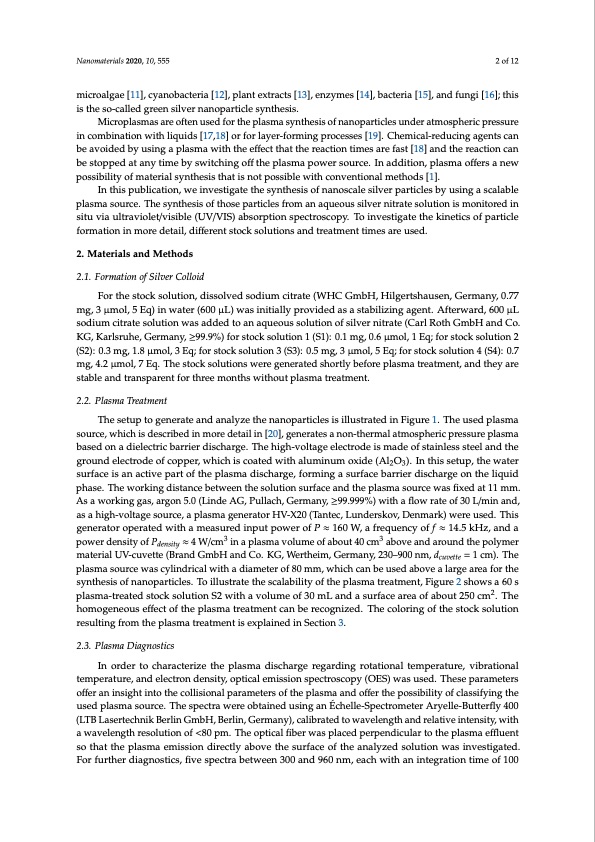
PDF Publication Title:
Text from PDF Page: 002
Nanomaterials 2020, 10, 555 2 of 12 microalgae [11], cyanobacteria [12], plant extracts [13], enzymes [14], bacteria [15], and fungi [16]; this is the so-called green silver nanoparticle synthesis. Microplasmas are often used for the plasma synthesis of nanoparticles under atmospheric pressure in combination with liquids [17,18] or for layer-forming processes [19]. Chemical-reducing agents can be avoided by using a plasma with the effect that the reaction times are fast [18] and the reaction can be stopped at any time by switching off the plasma power source. In addition, plasma offers a new possibility of material synthesis that is not possible with conventional methods [1]. In this publication, we investigate the synthesis of nanoscale silver particles by using a scalable plasma source. The synthesis of those particles from an aqueous silver nitrate solution is monitored in situ via ultraviolet/visible (UV/VIS) absorption spectroscopy. To investigate the kinetics of particle formation in more detail, different stock solutions and treatment times are used. 2. Materials and Methods 2.1. Formation of Silver Colloid For the stock solution, dissolved sodium citrate (WHC GmbH, Hilgertshausen, Germany, 0.77 mg, 3 μmol, 5 Eq) in water (600 μL) was initially provided as a stabilizing agent. Afterward, 600 μL sodium citrate solution was added to an aqueous solution of silver nitrate (Carl Roth GmbH and Co. KG, Karlsruhe, Germany, ≥99.9%) for stock solution 1 (S1): 0.1 mg, 0.6 μmol, 1 Eq; for stock solution 2 (S2): 0.3 mg, 1.8 μmol, 3 Eq; for stock solution 3 (S3): 0.5 mg, 3 μmol, 5 Eq; for stock solution 4 (S4): 0.7 mg, 4.2 μmol, 7 Eq. The stock solutions were generated shortly before plasma treatment, and they are stable and transparent for three months without plasma treatment. 2.2. Plasma Treatment The setup to generate and analyze the nanoparticles is illustrated in Figure 1. The used plasma source, which is described in more detail in [20], generates a non-thermal atmospheric pressure plasma based on a dielectric barrier discharge. The high-voltage electrode is made of stainless steel and the ground electrode of copper, which is coated with aluminum oxide (Al2O3). In this setup, the water surface is an active part of the plasma discharge, forming a surface barrier discharge on the liquid phase. The working distance between the solution surface and the plasma source was fixed at 11 mm. As a working gas, argon 5.0 (Linde AG, Pullach, Germany, ≥99.999%) with a flow rate of 30 L/min and, as a high-voltage source, a plasma generator HV-X20 (Tantec, Lunderskov, Denmark) were used. This generator operated with a measured input power of P ≈ 160 W, a frequency of f ≈ 14.5 kHz, and a power density of Pdensity ≈ 4 W/cm3 in a plasma volume of about 40 cm3 above and around the polymer material UV-cuvette (Brand GmbH and Co. KG, Wertheim, Germany, 230–900 nm, dcuvette = 1 cm). The plasma source was cylindrical with a diameter of 80 mm, which can be used above a large area for the synthesis of nanoparticles. To illustrate the scalability of the plasma treatment, Figure 2 shows a 60 s plasma-treated stock solution S2 with a volume of 30 mL and a surface area of about 250 cm2. The homogeneous effect of the plasma treatment can be recognized. The coloring of the stock solution resulting from the plasma treatment is explained in Section 3. 2.3. Plasma Diagnostics In order to characterize the plasma discharge regarding rotational temperature, vibrational temperature, and electron density, optical emission spectroscopy (OES) was used. These parameters offer an insight into the collisional parameters of the plasma and offer the possibility of classifying the used plasma source. The spectra were obtained using an Échelle-Spectrometer Aryelle-Butterfly 400 (LTB Lasertechnik Berlin GmbH, Berlin, Germany), calibrated to wavelength and relative intensity, with a wavelength resolution of <80 pm. The optical fiber was placed perpendicular to the plasma effluent so that the plasma emission directly above the surface of the analyzed solution was investigated. For further diagnostics, five spectra between 300 and 960 nm, each with an integration time of 100PDF Image | Formation Kinematics of Plasma-Generated Silver Nanoparticles

PDF Search Title:
Formation Kinematics of Plasma-Generated Silver NanoparticlesOriginal File Name Searched:
nanomaterials-10-00555-v2.pdfDIY PDF Search: Google It | Yahoo | Bing
Turbine and System Plans CAD CAM: Special for this month, any plans are $10,000 for complete Cad/Cam blueprints. License is for one build. Try before you buy a production license. More Info
Waste Heat Power Technology: Organic Rankine Cycle uses waste heat to make electricity, shaft horsepower and cooling. More Info
All Turbine and System Products: Infinity Turbine ORD systems, turbine generator sets, build plans and more to use your waste heat from 30C to 100C. More Info
CO2 Phase Change Demonstrator: CO2 goes supercritical at 30 C. This is a experimental platform which you can use to demonstrate phase change with low heat. Includes integration area for small CO2 turbine, static generator, and more. This can also be used for a GTL Gas to Liquids experimental platform. More Info
Introducing the Infinity Turbine Products Infinity Turbine develops and builds systems for making power from waste heat. It also is working on innovative strategies for storing, making, and deploying energy. More Info
Need Strategy? Use our Consulting and analyst services Infinity Turbine LLC is pleased to announce its consulting and analyst services. We have worked in the renewable energy industry as a researcher, developing sales and markets, along with may inventions and innovations. More Info
Made in USA with Global Energy Millennial Web Engine These pages were made with the Global Energy Web PDF Engine using Filemaker (Claris) software.
Infinity Turbine Developing Spinning Disc Reactor SDR or Spinning Disc Reactors reduce processing time for liquid production of Silver Nanoparticles.
| CONTACT TEL: 608-238-6001 Email: greg@infinityturbine.com | RSS | AMP |